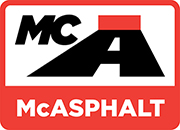Design Fundamentals 101
HMA consists of two basic ingredients: aggregate and asphalt binder.
Hot mix asphalt (HMA) consists of two basic ingredients: aggregate and asphalt binder. HMA design is the process of determining which aggregate to use, which asphalt binder is needed, and what the optimum combination of these two ingredients ought to be. There are several different methods used to go about this process. The two most common methods are the Marshall and Superpave methods.arshall and Superpave methods are the most common.
By manipulating the variables of the aggregate and asphalt binder, as well as the ratio between the two, the mix design process seeks to achieve the following qualities in the final HMA product:
Deformation resistance:
HMA should not distort (rut) or deform (shove) under traffic loading. HMA deformation is related to aggregate surface and abrasion characteristics, aggregate gradation, particle shape, asphalt binder content, and asphalt binder viscosity at high temperatures.
Fatigue resistance:
HMA should not crack when subjected to repeated loads over time. HMA fatigue cracking is related to asphalt binder content, asphalt binder type, as well as its stiffness.
Low temperature cracking resistance:
HMA should not crack when subjected to low ambient temperatures. Low-temperature cracking is primarily a function of the asphalt binder low temperature stiffness.
Durability:
HMA should not age excessively during production and its service life. HMA durability is related to air voids as well as the asphalt binder film thickness around each aggregate particle.
Moisture damage resistance:
HMA should not degrade substantially from moisture penetration into the mix. Moisture damage resistance is related to air voids as well as aggregate mineral and chemical properties. Anti-stripping additives are often required to promote bonding between the asphalt cement and the aggregates.
Skid resistance:
HMA placed as a surface course should provide sufficient friction when in contact with a vehicle’s tire. Low skid resistance is generally related to aggregate characteristics or high asphalt binder content.
Workability:
HMA must be capable of being placed and compacted with reasonable effort. Workability is generally related to aggregate texture/shape/size/gradation, asphalt binder content, and asphalt binder viscosity at mixing and placement temperatures.
